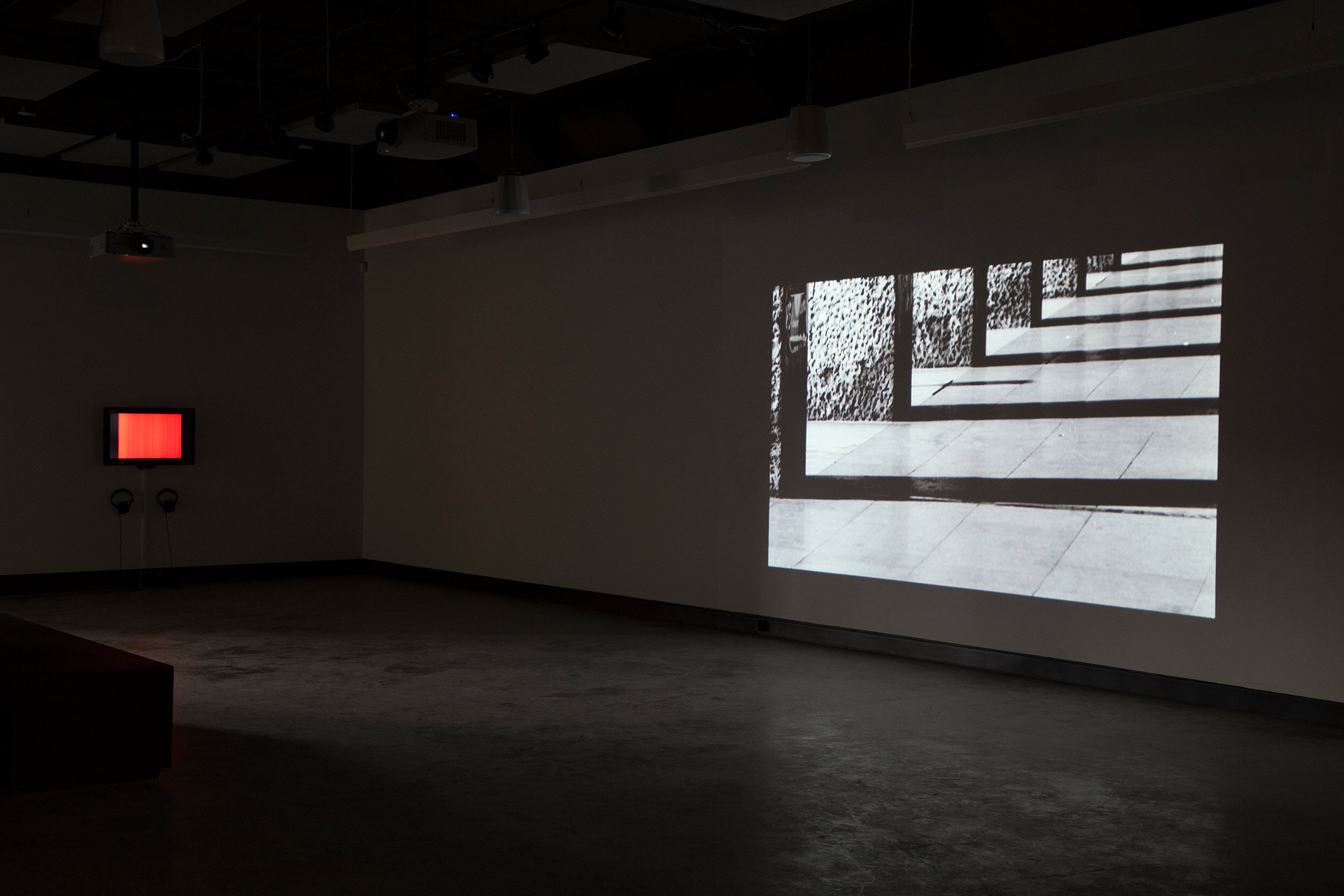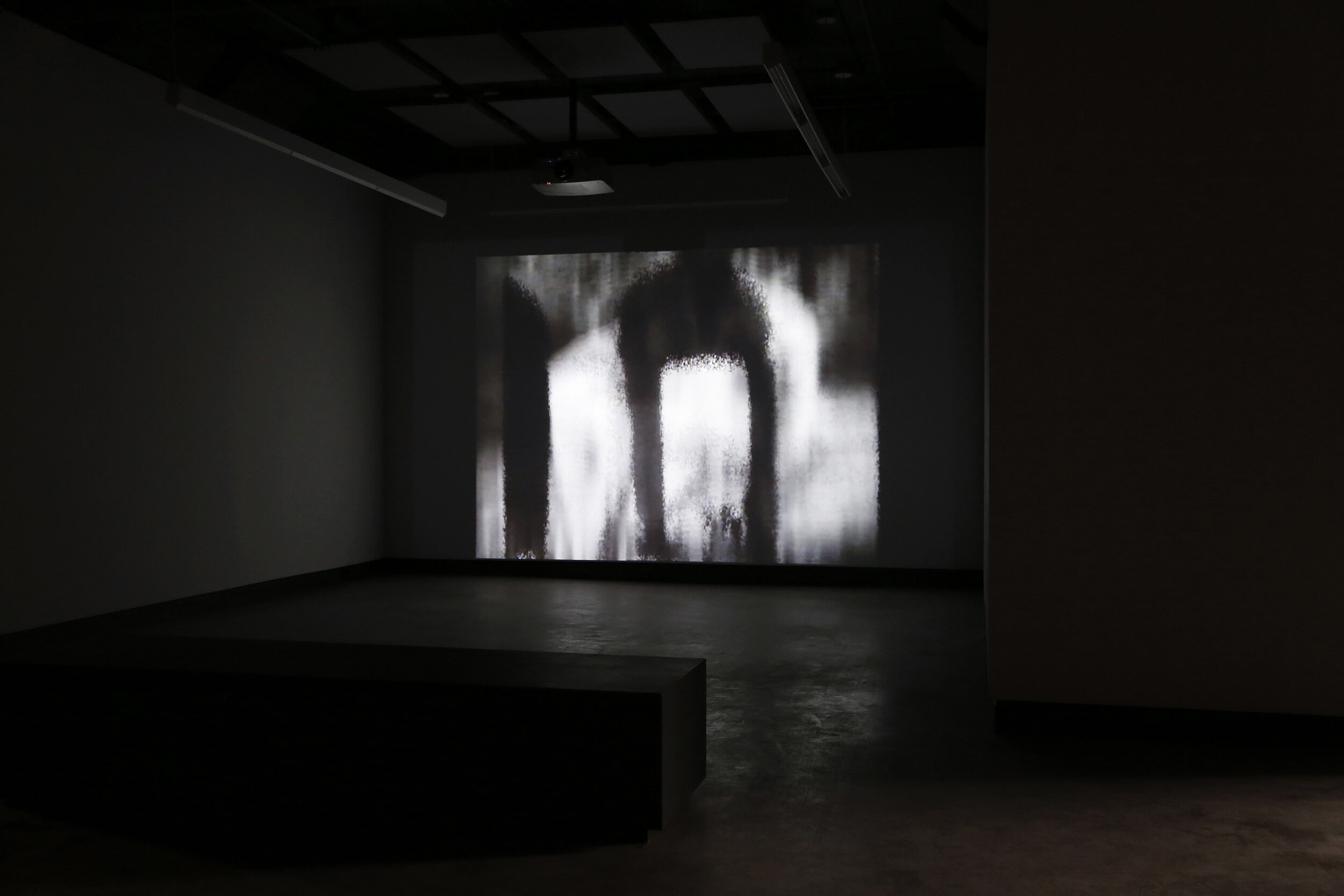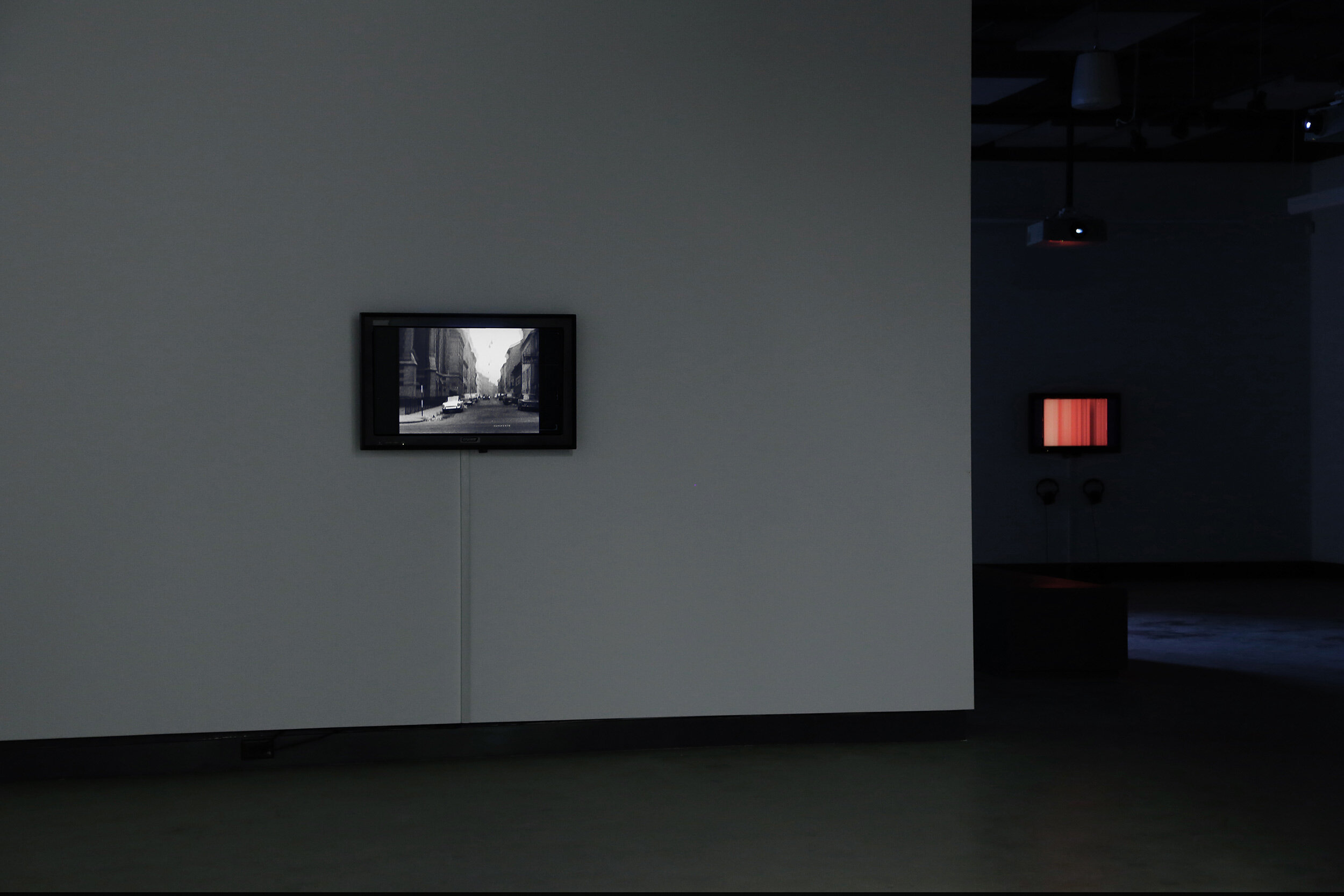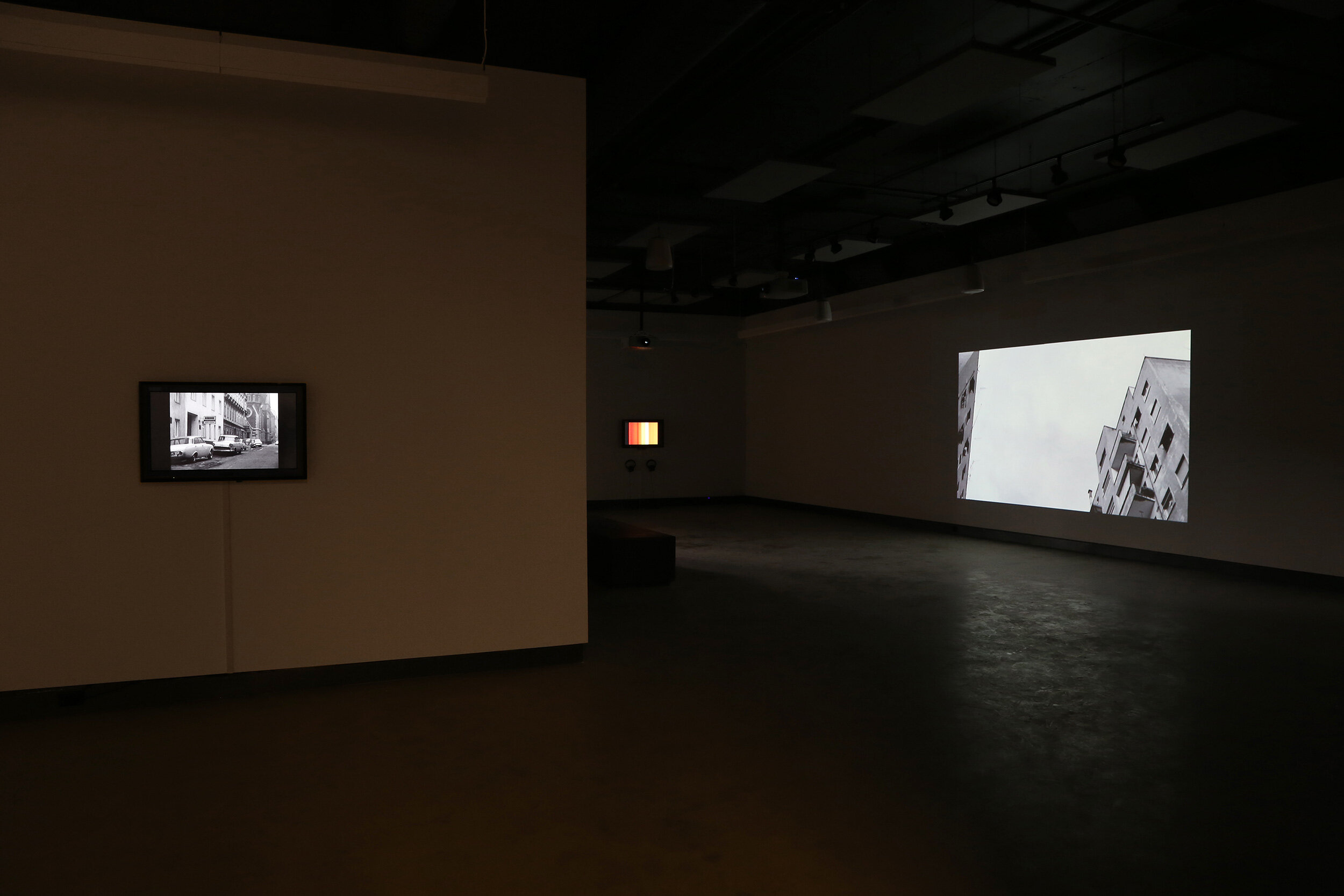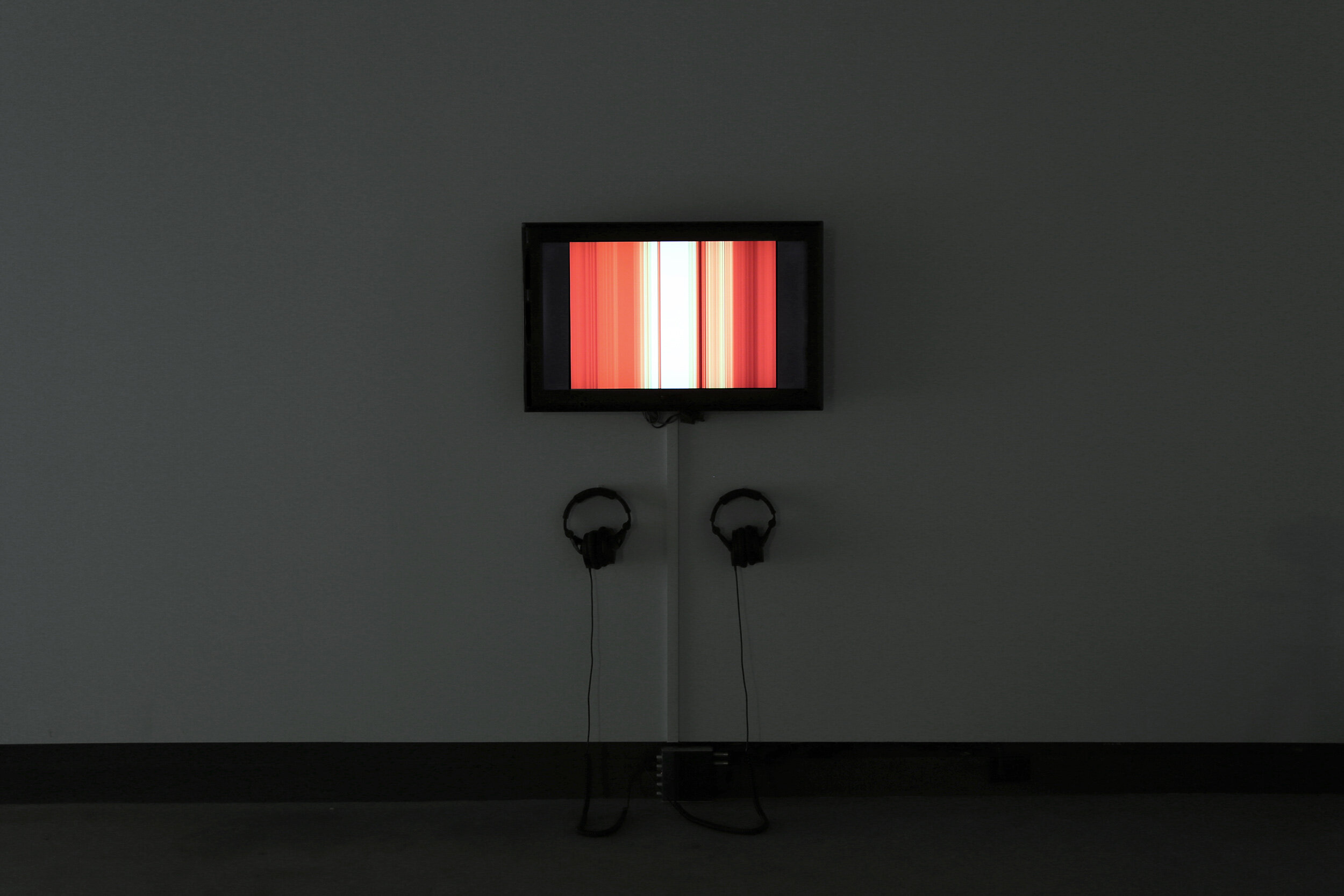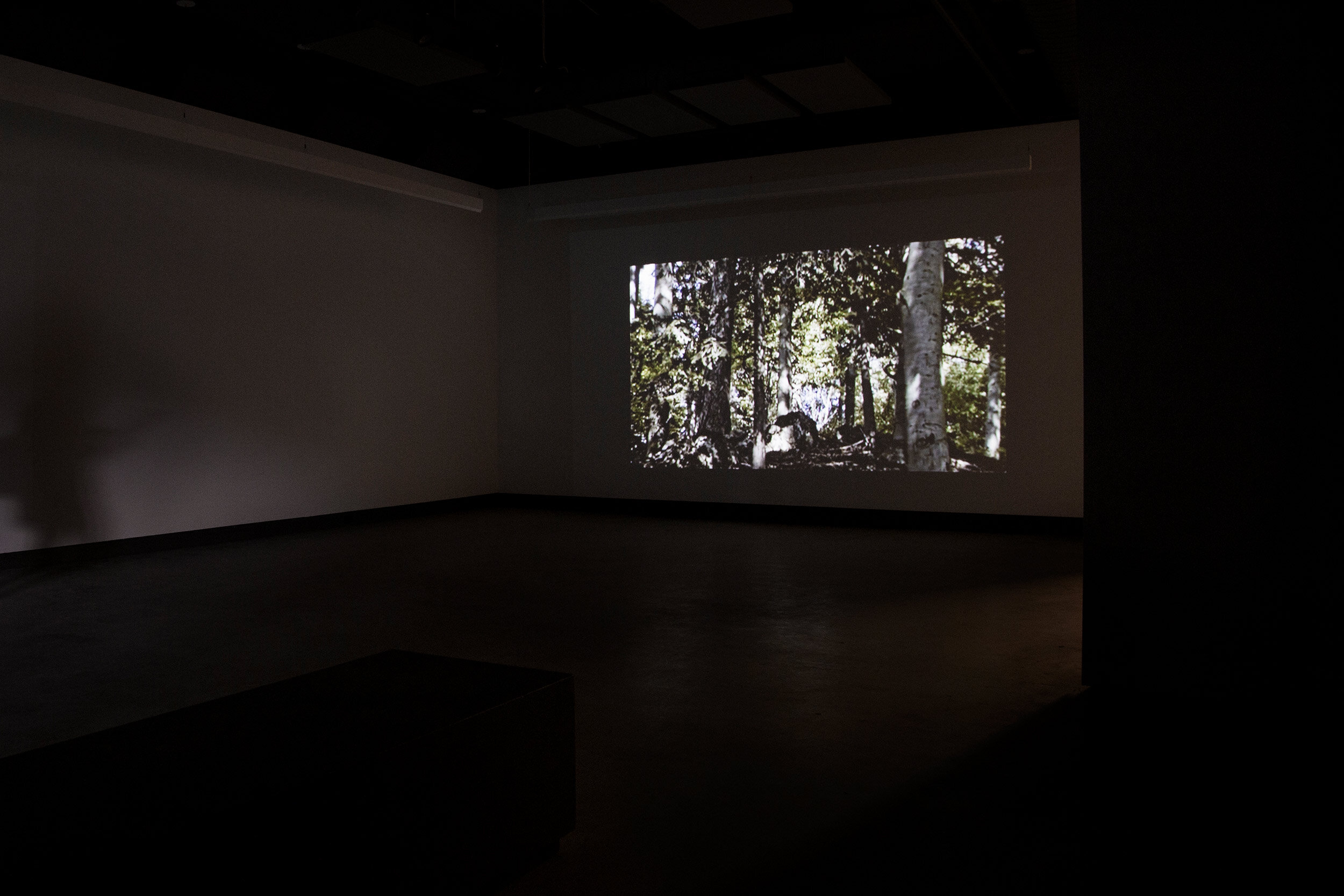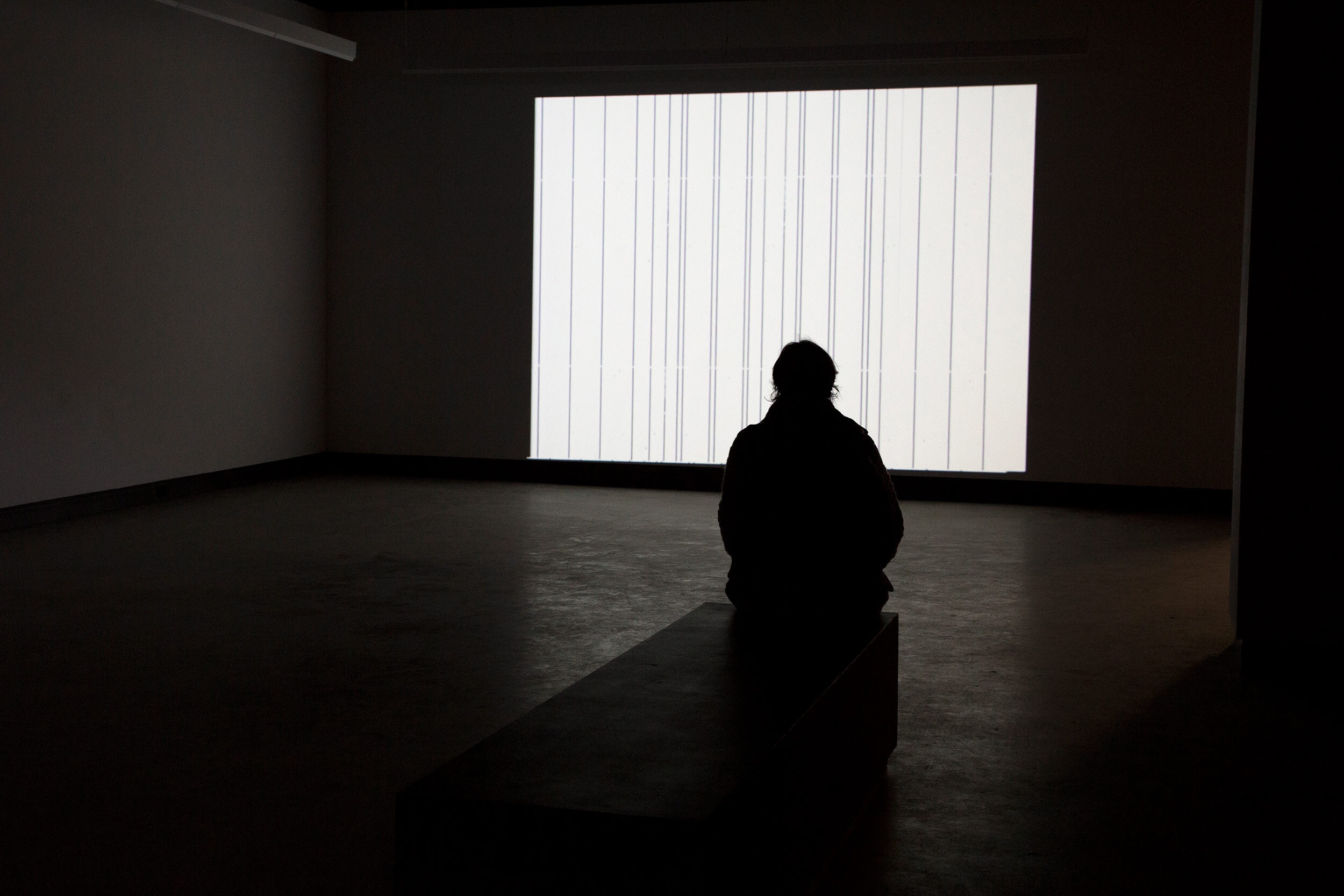Electronic Sound in a Shifting Landscape
From July 18 to September 13, 2014
Opening on July 18 at 8 pm
Programmed by Steve Bates in collaboration with sixpackfilm and Index DVD (Vienna) including works by Siegfried A. Fruhauf, Michaela Grill, Elke Groen, Dariusz Kowalski, Annja Krautgasser, Kurt Kren, Johann Lurf, Dietmar Offenhuber, Billy Roisz, Leo Schatzl, Hans Scheugl, Lotte Schreiber, Michaela Schwentner and Peter Weibel
Dazibao has invited Steve Bates to prepare an exhibition including artworks articulated around the peculiar relationship that can exist between sound and image. Steve Bates, with the collaboration of Vienna distributor sixpackfilm and Index DVD puts together Electronic Sound in a Shifting Landscape, a kind of personal anthology of the austrian audiovisual production from the 1960s to this day.
Austria’s take on experimental film and video is outstanding and unique in many regards; from the structuralist and full-bodied approaches of the early days to bit crunching contemporary artists blending sound, video and performance. Electronic Sound in a Shifting Landscape attempts to connect some of the migrations between these historical moments.
In all of these collected film and video works from 1960 to 2008, landscape and sound play critical roles and it is this arc that this program traverses. This collection is broad in consideration; from the systematized nature scenes of Kurt Kren’s early films to the mapping of a single roll of film onto the city in Hans Scheugl’s Wien 17, Schumanngasse (1967), to the urban grid in pixelated landscapes of the younger generations represented here.
Beginning with Hans Scheugl’s Wien 17, Schumanngasse, we see an early structuralist work where the filmmaker drives a car the length of Schumann Street taking the same time to expose a single roll of 16 mm film stock. The 30 meter length of the film stock taking 2 and a quarter minutes at 24 frames per second. Here the speed of the camera determines the velocity of the car through the city.
Wien 17, Schumanngasse is one of two films in this exhibition which do not have sound. But does this mean there is no soundtrack? In Wien 17, Schumanngasse we can almost hear the bouncing of the car through Vienna’s rough street. The car’s engine accelerating and decelerating as Scheugl carefully administers speed to reach his destination on time. Upon knowing the method of this film, it is as if we can hear a stop-watch counting down, or the camera teeth chewing through the film sprockets, adding an otherwise unknown tension to an otherwise innocuous film.
In Kurt Kren’s time-lapse study, Tree Again (1978) there is also no sound. But there is a musicality in the movement of images captured across a summer on special, infra-red film creating a pastoralism not often associated with the artist’s work. Not only are there the implied sounds of the passing season but flashes of events pass through the image; condensation trails from a passing airplane, gusts of wind across tree branches and leaves, and grazing animals. All of these sonic elements considered by the viewer.
If we consider the collected soundtracks of all the films playing in the gallery as a whole, a sort of accumulated new sound work, Tree Again provides a necessary pause in the composition, an interval, a space in between. In melodic theory, the interval is what allows our brains to determine melody; again demonstrating sound requires the spaces between it’s own noise to be whole.
In Kren’s 3/60 Bäume im Herbst (Trees in Autumn) (1960), a structuralist study of flickering tree branches, one may misinterpret the sound as a sort of lo-fi rumble of damaged optical film sound but Kren actually painted the soundtrack onto the filmstrip with India ink. The resulting low-pitched rumble is beautiful in its simplicity and timbre. Here the soundtrack aids our ability to meld the images into a whole, repairing the fast-paced visual ruptures of each frame. The soundtrack’s legato (bound) helping to smooth the film’s staccato (detached).
Peter Weibel’s Abbildung ist ein Verbrechen (Depiction is a Crime) (1970) and Intervalle (1971) are conjoined works that investigate telecommunication’s structural transfer where the sender receives “his message back in reverse form”. Standing in the park grounds of Vienna’s Schönbrunn Castle, former seat of the Austrian emperor, a narrator (Weibel himself) describes the transfer process between mediums while the ambient sound of the park can be heard in the background. The narrator turns a Polaroid camera on the film crew and snaps a photo of them. In Intervalle, this image is broadcast on a television installed in the same immaculately detailed formal garden while a sine wave test tone, typically used in television tests and calibrations, fades in volume as the television disappears into the horizontal (hold) perspective line. Interesting here is the overlap of the ‘man-made’ formalism of the garden and the sine wave, a sound which cannot occur in nature. This overlay of image and sound supports another reading on landscape, man’s own image of nature back onto himself in the symmetry of the park design and management and control of the ‘natural’.
A number of works in this collection employ time-lapse to exaggerate the landscape’s spatial relationship to time. The formerly mentioned Kren film, Tree Again, and also his 46/90 Falter 2 (1990), originally an advertisement film for the city newspaper, Falter. Like the seemingly endless stream of trains in Falter 2, Leo Schatzl’s Tabu Zone #2 (1998) depicts a “taboo zone” cordoned off, fenced in as the seasons endlessly pass over it. Its relentless soundtrack feeling like small grinding motors acting as the mechanics of time itself. The looping, repetitive sounds giving the fenced off landscape a sort of absurdist protective wrapping. But from what? Or who?
Elke Groen’s NightStill (2008) contrasts the apparent stationary element of the Austrian Alps with time-lapse footage revealing endless movement in everything. The electronic soundtrack changes rapidly to highlight these dramatic elements of a nature ‘sped up’. The occasional human figure in the landscape remains relatively motionless while the universe spins smoothly around them.
Dariusz Kowalski’s Luukkaankangas – updated, revisited (2005), utilizes webcam footage of the Finnish Road Administration of roadways throughout the countryside. With a soundtrack by Radian’s Stefan Németh, the lo-fi footage of snowy country highways takes on a melancholic tone while a winter passes. Snow and shadow obscuring the unnatural road lines to an almost romantic soundtrack.
Lotte Schreiber’s Borgate (2008), studies the urban landscape of the modernist Don Bosco housing project in Rome with dramatic symphonic soundtrack by Bernhard Lang. Borgate uses slow panning shots and quotes by Pasolini, Fellini, and Antonioni to investigate architecturally and acoustically this failed utopia.
In Siegfried A. Fruhauf’s Höhenrausch (Mountain Trip) (1999) scrolling images of postcards of the iconic Austrian Alps flow by. Their undulating, inverted mountain tops taking on a surreal, warped graphic representation of a sine wave here playing off the distorted out-of-tune Alpine folk music. With Höhenrausch, sound and image invite us to question nationalist stereotypes of landscapes and culture and their often awkward and embarrassing representations.
Dietmar Offenhuber’s paths of g (2006) is another surreal representation of landscape. Here Offenhuber retains the original soundtrack from Stanley Kubrick’s Paths of Glory, but processes the image digitally into a fragmented, pixelated landscape perhaps best representing the surreal landscape of World War I trench warfare. With most of the original image removed, replaced only by coloured blocks minimally indicating the trench contours, the soundtrack reveals the absurdity of the situation the troops find themselves in. A once coherent, whole landscape now shattered beyond recognition.
This identification of the pixel brings us to a body of work developed over the 1990’s and into the 2000’s by Austria’s younger generation of video makers employing computers and electronic music traditions in their digital investigations of sound and landscape. Often the work of this generation crosses between cinema, nightclub and concert settings not particularly showing allegiance to any one venue. This has also infused the work with a questioning of the boundaries between art and music video. These boundaries are stretched and rendered unclear. There is an anti-art approach to much of this work that questions the relationship between high/bourgeois art and everyday experience in the street and in clubs. Many from this younger generation grew up through the politics of punk and the DIY organization of early techno and it’s political ramifications. This questioning also relates to similar challenges put forward by Vienna’s Actionist movement and the films that emerged from that group.
Annja Krautgasser, Billy Roisz, and Michaela Grill come from this younger generation and their work, while very different from each other, share some of the same approaches. One such approach is the idea that image and sound share the same weight in their work. The sound does not serve the image but meets it on equal footing. Some of these works credit the musicians equally to the video-maker.
This makes sense also when one considers that Grill and Roisz also perform live alongside musicians and employ software that allows for a total interpenetration of sound and image where visual elements provide control data for sonic parameters and vice versa lending an organic relationship between sound and image to much of this work.
The works frame (2002, Annja Krautgasser), NOT STILL (2008, Billy Roisz), cityscapes (2007) and Hello Again (2006) (Michaela Grill), all have a resolute literalness to them while appearing often wholly abstract. Krautgasser and Grill’s processed city images and Roisz’s extreme close-up of the landscape of a vinyl record all grounded in a literal vision abstracted through scale, overlay, colour saturation, and grain along with a highly composed soundtrack of electronic music.
This film and video program is book-ended by performances by two groups, Le Révélateur (Roger Tellier-Craig and Sabrina Ratté) and Total Life (Kevin Doria) with Karl Lemieux. Both of these groups work visuals and music into a wide, organic experience that possess links to Austria’s work ethic in its approach to a whole-bodied, audio-visual experience.
Steve Bates
PROGRAM
SIEGFRIED A. FRUHAUF
Siegfried A. Fruhauf (1976) works with film, video and photography and questions the fabrication process of the image. He intervenes methodically on the filmic material in order to make the hidden mechanisms of the cinematographic process visible. His work is shown at important film festivals, including Cannes and Sundance.
Höhenraush (Mountain Trip) (1999) — 4 min., 16 mm, music by Rainer Gamsjäger
Höhenrausch is a cinematic myriorama constructed of hundreds of Austrian postcards, which reflect a country’s hackneyed trappings as no other medium can.
MICHAELA GRILL
Michaela Grill (1971) studied in Vienna, Glasgow and London. Since 1999 she has realized various film and video works, installations and live visuals as well as performances in Austria and abroad. She regularly performs in Montreal.
cityscapes (2007) — 16 min., soundtrack by Martin Siewert
cityscape uses archived recordings from the Austrian Film Museum. Single images are isolated from the cinematographic flow in order to scrutinise their inscribed cognitive potential.
Hello Again (2006) — 5 min., sountrack by trapist
Hello Again is a colourful road movie, a classic music video, both in terms of its production (pictures set to an existing music track) and the intention behind it.
ELKE GROEN
Elke Groen (1969) studied architecture and photography and has worked since 1995 as an editor and filmmaker. She is the author of experimental short films as well as feature documentaries, in collaboration with Ina Ivanceanu.
NightStill (2008) — 9 min., 35 mm, sound design by Dietmar Schipek
The apparent stationary element of the Austrian Alps contrast with time-lapse footage revealing endless movement in everything.
DARIUSZ KOWALSKI
Dariusz Kowalski (1971), also known as Dariusz Krzeczek, studied visual media arts at the University of Applied Arts in Vienna. A founding member of the collective Vidok (2000-2005), he works in video, installation and audiovisual performance.
Luukkaankangas – updated, revisited (2005) — 7 min., sound by Stefan Németh
Low-fi melancholic footage of the finnish country highways utilizing the pictures taken every 10 or 15 minutes by the webcams of the Finnish Transport Agency.
ANNJA KRAUTGASSER
Annja Krautgasser (1971) is a media artist and an architect. Her Internet projects, CD-Rom and video works have been screened and exhibited internationally. She is a founding member of the collective VIDOK (2000-2005).
frame (2002) — 5 min., music by Radian
A car ride through a city. So much “reality” has been removed from the original views of this ride that solely remnants and a basic structure comprise the video image.
KURT KREN
Kurt Kren (1929-1998) is a precursor in the destruction of spatial and temporal continuity in film that gave rise to expanded cinema. From his well-known documentation of the Vienna actionnists in the 1960s to his death, he has left a major and celebrated work.
37/78 Tree Again (1978) — 3 min., 16 mm, silent
A large and splendid tree surrounded by bushes and a stretch of pastureland from summer to autumn. The film is made from a series of individual pictures taken from the same camera position and shot with a highly sensitive infra-red colour film.
3/60 Bäume im Herbst (Trees in Autumn) (1960) — 5 min., 16 mm
A structuralist study of flickering tree branches. The soundtrack was painted by the filmmaker onto the filmstrip with India ink.
46/90 Falter 2 (1990) — 0 min., 35 mm, bande son de Wolfgang Ernst
A seemingly endless stream of trains, originally an advertisement for a Vienna newspaper.
JOHANN LURF
Johann Lurf (1982) studied in art academies in Vienna and London. His short films and installations have been screened and awarded at multiple international festivals such as the Vienna International Film Festival, Melbourne International Film Festival and the International Film Festival Rotterdam.
VERTIGO RUSH (2007) — 19 min., 35 mm
VERTIGO RUSH is a succession of images, of forward and backward camera movements and of zooms; the intensified acceleration making the image “dissolved”. Employing the “dolly zoom”, first used by Hitchcock in his film Vertigo, Lurf creates a frenetic and hallucinatory film disrupting our conventional modes of perception.
DIETMAR OFFENHUBER
Dietmar Offenhuber (1973) holds a PhD in Urban Planning from MIT, a Master’s Degree in Media Arts and Sciences from the MIT Media Lab, and a degree in Architecture from the Vienna University of Technologie. His research focuses on the role of new technologies and representation in urban governance and civic discourse. His artistic work has been exhibited internationally.
paths of g (2006) — 1 min., original soundtrack from the film by Stanley Kubrick
A variation on Stanley Kubrick’s Paths of Glory: a long travelling shot of a World War I trench is visually reduced to its essentials, while the original soundtrack remains.
BILLY ROISZ
Since the late 1990s, Billy Roisz (1967) deals intensively with video and sound. Her work focuses on the links and gaps between visual and auditive perception. She is one of the best known figures of the Austrian experimental scene and has won numerous awards.
NOT STILL (2008) — 10 min., soundtrack by dieb13 and eRikm
The source for the pictures and sounds in NOT STILL is a vinyl record. Initially, a sample dominates: the scratching of a record player needle in an endless loop.
LEO SCHATZL
Leo Schatzl (1958) concentrates on installations, objects, imaging media. The ironic analysis of systems of social control; pseudo-scientific technical experiments, and the “manipulation” of our visual habits with the help of apparatus are central aspects of his work.
Tabu Zone #2 (1998) — 4 min. 10 sec., soundtrack by Leo Schatzl
A “taboo zone” cordoned off, fenced in as the seasons endlessly pass over it during a period of 5 years.
HANS SCHEUGL
Hans Scheugl (1940) was a member of the avant-garde that helped establish structural film and expanded cinema in Europe in the 1960s. His works are concerned with real time/film time and with film as material and reality.
Wien 17, Schumanngasse (1967) — 3 min., 16 mm, silent
The filmmaker drives a car the length of Schumann Street in Vienna taking the same time to expose a single roll of 16 mm film stock.
LOTTE SCHREIBER
A filmmaker and an artist, Lotte Schreiber (1971) studied architecture. Her work has been shown at diverse exhibitions and film festivals and has won many prizes, including Best Experimental film at the New York Underground Film Festival (2003).
Borgate (2008) — 15 min., music by Bernhard Lang
A topographic exploration of the modernist Don Bosco housing project in southern Rome, originally intended to be modern Italy’s showcase urban project after World War II.
MICHAELA SCHWENTNER
Michaela Schwentner (1970) lives in Vienna where she teaches at the Institute of art and design of the Vienna University of Technologie and at the Vienna Film Academy. She is a conceptual artist working with video, film and sound. Her work is regularly featured in exhibitions and important festivals, including the Sundance Film Festival, Cork Film Festival and the International Film Festival Rotterdam.
Jet (2003) — 6 min., sound by Radian
Through her film work, Michaela Schwentner explores in a very refined way and in a minimal style (soundtrack, color, compositions and patterns) the idea of bstraction captured by the moving image. The artist offers new ways of thinking about the nature of film, video and computer images.
PETER WEIBEL
Peter Weibel (1944) studied literature, film, mathematics, medicine and philosophy in Vienna and Paris. He is an artist, curator, art and media theorist. Throughout his practice, he examines the relationship between media and the construction of reality.
Abbildung ist ein Verbrechen (1970) — 1 min. 30 sec.
Standing in the park grounds of Vienna’s Schönbrunn Castle, former seat of the Austrian emperor, Weibel describes the transfer process between mediums.
Intervalle (1971) — 1 min.
In the same garden a sine wave test tone, a sound which cannot occur in nature and typically used in television tests and calibrations, fades in volume as a television broadcasting the image from Abbildung ist ein Verbrechen disappears into the perspective line.
Vienna’s sixpackfilm is a respected distributor of Austrian experimental film and video. Index DVD is sixpackfilm’s publishing house consisting of video and film collections and artist’s works. Index has kindly agreed to make available their catalogue to Dazibao for this exhibition.
An artist, musician and occasional curator, Steve Bates holds a Master’s degree in Visual Arts from Concordia University. The sonic is the starting point for projects which are evocations of communication networks and systems, or that bring out the characteristics of the space. Using sound, he measures, bends, ignores or stretches time, thus seeking to modulate the viewer’s experience of the site. He has exhibited in Canada, the United States, Europe and most recently, Senegal. In September 2014, his works can be seen at Oboro.
Le Révélateur started in 2008 as a solo venture for Montreal-based electronic musician Roger Tellier-Craig. It has since then expanded into an audio-visual duo with the inclusion of video artist Sabrina Ratté in 2010. Together they explore a common fascination for the combination of electronic image and sound, using a varying array of digital and analogue technologies.
Total Life is the solo project of Kevin Doria, founding member of the band Growing. Doria has participated in a number of collaborations with David Bryant (GY!BE), Jonathan Parant (Fly Pan Am), as well as filmmaker, Karl Lemieux. As Total Life, Doria has released several records with Animal Disguise Records, Brownsounds, Debacle Records, and, most recently, Important Records. He has also performed all over North America and Europe.
In his performances, Karl Lemieux uses up to eight 16mm projectors to transform looped film while it is being projected. He creates successive superimpositions of images that he paints, bleaches, scratches, burns and slices with a razor blade. In his hands, celluloid is literally destroyed before the viewer’s eyes, releasing incandescent images. While Lemieux’s work may be inspired by the dialogue that occurs between film and sound art, it focuses on a process that involves inner sensations.
Performance
Le Révélateur
On July 18, 2014 at 9 pm
Discussion
Michaela Grill
On September 4, 2014 at 7 pm
Performance
Total Life + Karl Lemieux
On September 13, 2014 at 9 pm
This exhibition was organised for Dazibao by Steve Bates. We thank Steve Bates, the artists, sixpackfilm and Index DVD for their generous collaboration as well as our members for their support.
Dazibao receives financial support from the Conseil des arts et des lettres du Québec, the Canada Council for the Arts, the Conseil des arts de Montréal, the Ministère de la Culture et des Communications and the Ville de Montréal.

